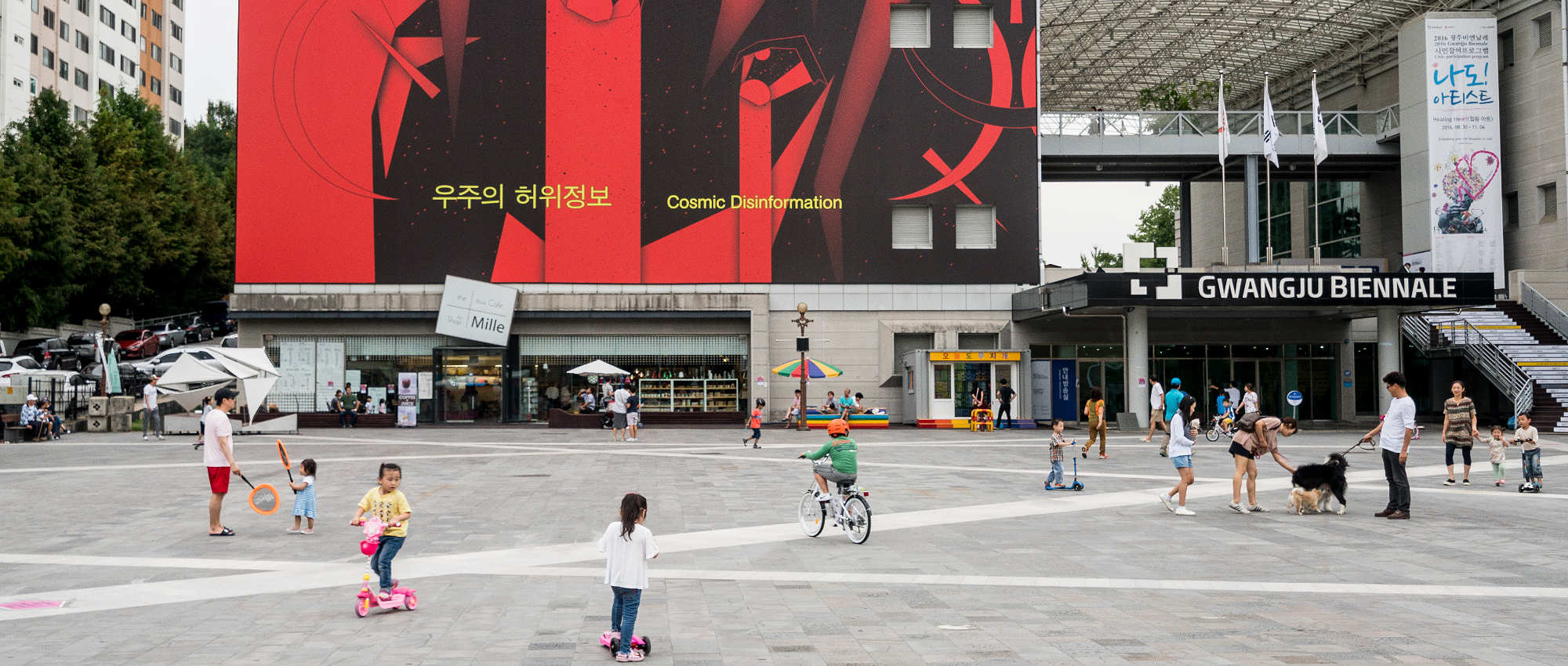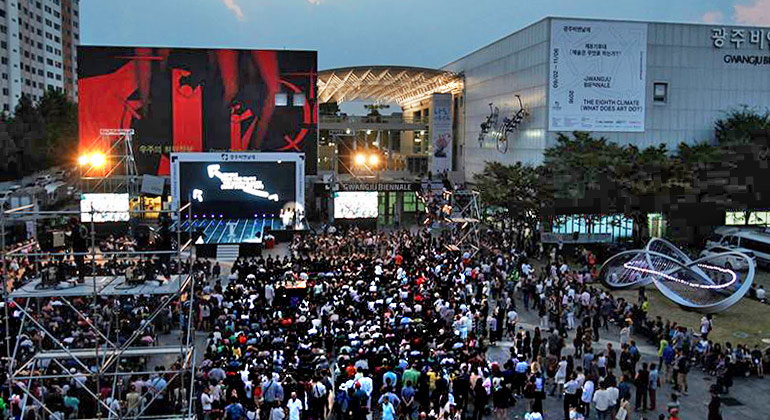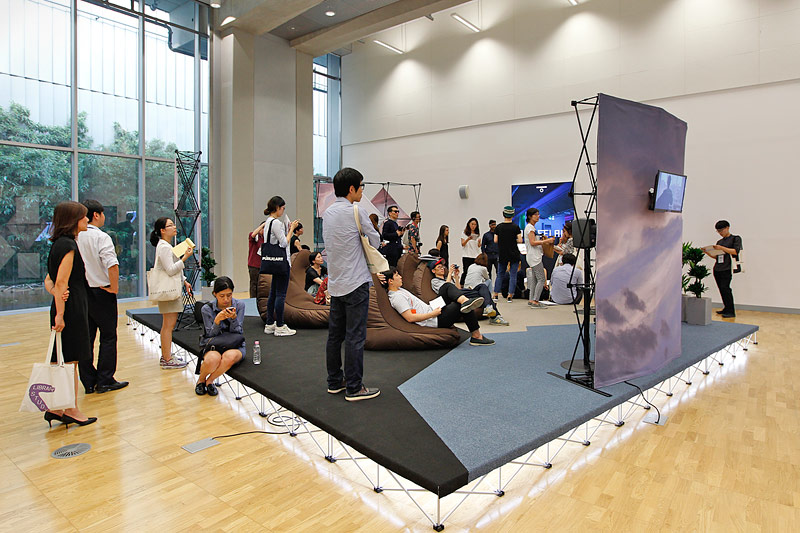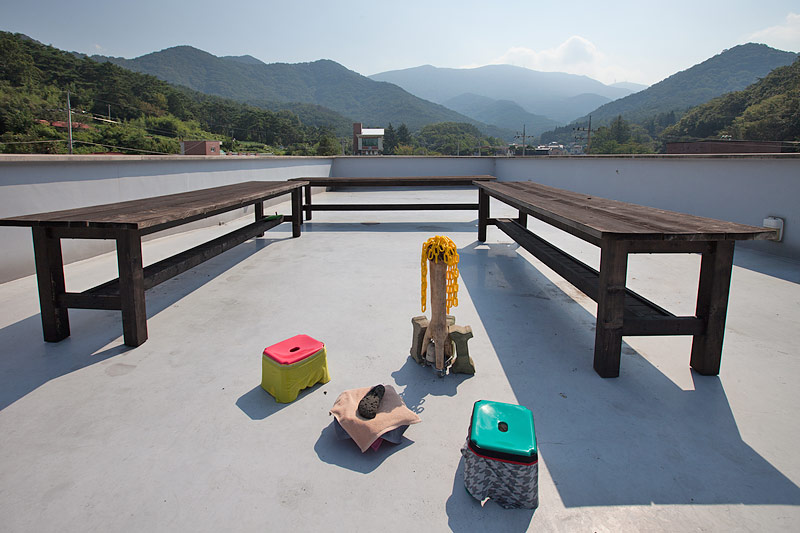Para la mejor vista de nuestra página web, use su dispositivo en forma horizontal.


The exhibition part of the 11th Gwangju Biennale entitled “The Eighth Climate (What Does Art Do?)” opened to the public on 2 September 2016. The title is not a “theme” or a “concept,” but rather indicates a set of parameters of GB11. It is about placing art centerstage, art’s capacity to always say something about the future, connect dots over small and big distances, embeddedness in particular situations, and mediation. What happens if we try to tease out more of the artworks in this eclectic, kaleidoscopic, and puzzling adventure? If we accept their invitation to engage, and take their interpellation more at face value? One of the things which we might end up doing is to enter a dance of futurity where the past is neither completely forgotten nor a guiding light. In this sense, GB11 is a temperature check of art today.
GB11 is also a constellation of many parts happening over one year, starting in January 2016. Thinking thoroughly about what art does—without necessarily implying a utilitarian approach—how artworks land in different contexts, and how they sit in society and create ripples on the water, GB11 comprises Monthly Gatherings, or Wol-rae-hoe, made together with the local curatorial associates Mite-Ugro in Gwangju, an Infra-School in Gwangju, Seoul, and beyond, around a hundred national and international Biennale Fellows, a Forum “To All the Contributing Factors” with the Fellows, two publications and a blog designed by Metahaven, as well as an exhibition which stretches from the Gwangju Biennale Exhibition Hall to other venues and places in the city, including: Asia Culture Center, 5.18 Archives, Mudeung Museum of Contemporary Art, Uijae Art Museum, Woo Jaeghil Art Museum, Mite-Ugro, Nuribom Community Center, Hansaebong Agriculture & Eco Park, The Roundabout Revolution, Seo-gu Culture Center, Daein Market.

The opening week was a moment to celebrate this ongoing process of conjunction, convergence, and multiplicity together with the ninety artists who were present, but also opening up the crucial nodal points for furthering the process and for debate, which includes the presentation of twenty-eight commissions and a lively program. Among the commissions are Dora García’s reconstruction of the Nokdu bookstore that played a crucial role in the 18 May 1980 Uprising in Gwangju, Cooperativa Cráter Invertido’s and Hu Yun’s engagement with the 5.18 Archives, Metahaven’s new film Information Skies, only available online, Jewyo Rhii with Jihyun Jung’s scattering storytelling machines for makers, and Gunilla Klingberg’s feng shui inspired vinyl cut-out moon-cycle patterns applied on the windows of the Uijae Museum by the Mudeung mountain.
Further artists who have been commissioned to make new work for GB11 are: Ahmet Öğüt, Amalia Pica, Ane Hjort Guttu, Annie Lai Kuen Wan, Apolonija Šušteršič, Babi Badalov, Bernd Krauß, Bik Van der Pol, Céline Condorelli, Christopher Kulendran Thomas, Claire Barclay, Dale Harding, Doug Ashford, Fernando Garcia-Dory, Hu Yun, Julia Sarisetiati, Natascha Sadr Haghighian, Ruth Buchanan, Saskia Noor van Imhoff, Søren Andreasen, Tommy Støckel, Trevor Paglen, and Tyler Coburn. In addition to a production budget for the GB11 commissions, there are, for the first time in the history of the Gwangju Biennale Foundation, fees for all participating artists.

The Eighth Climate of the exhibition’s title refers to a state, or inter world, one might reach using imaginative capacities. The notion of the eighth climate dates back to 12th-century Persian mystic and philosopher Sohrevardi, and was elaborated by 20th-century French philosopher Henri Corbin. It is an addition to the seven physical climates of the Earth identified by ancient Greek geographers. Unlike the seven Earthly climates, the eighth climate is not based on a separation of matter and spirit, history and myth; rather, it is ontologically real and has concrete effects. It is characterized by its imaginative qualities and potentiality. In this way, the eighth climate shows interesting parallels with how contemporary art is functioning.
The eighth climate might well resonate with global warming. However, in the context of GB11, the eighth climate helps us explore art’s capacity to say and do something about the future, without either being paralyzed by its prospects or defaulting to established technologies of prediction. The eighth climate evokes art as a seismograph, detecting change before other means of observation, whether the artists are conscious of it or not, allowing for slightly different—and perhaps ambiguous and conflictual perspectives on how art engages with what lies ahead of us. This neither implies art for art’s sake nor a utilitarian approach. It is not about “art for art’s sake” but rather about “art itself.”
More information is available at the Metahaven-designed blog www.the8thclimate.org.
(From the curatorial team: Maria Lind, artistic director, Binna Choi, curator, Azar Mahmoudian, Margarida Mendes, and Michelle Wong, assistant curators. Press information: 5 September 2016. Drawings: Bernd Krauss, Courtesy of the artist)